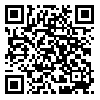Volume 10, Issue 1 (2019)
LRR 2019, 10(1): 223-249 |
Back to browse issues page
Download citation:
BibTeX | RIS | EndNote | Medlars | ProCite | Reference Manager | RefWorks
Send citation to:



BibTeX | RIS | EndNote | Medlars | ProCite | Reference Manager | RefWorks
Send citation to:
Eftekhar Z, Agha-Husseini H, Algooneh Juneghani M. The Application of Semiotic Square in the analysis of Rouzbahan Baghli’ s language. LRR 2019; 10 (1) :223-249
URL: http://lrr.modares.ac.ir/article-14-21181-en.html
URL: http://lrr.modares.ac.ir/article-14-21181-en.html
1- University of Isfahan
2- Professor of Persian language and literature ,h.aghahosaini@yahoo.com
3- Assistant professor of Persian language and literature
2- Professor of Persian language and literature ,
3- Assistant professor of Persian language and literature
Abstract: (7979 Views)
Rouzbahan Baghli is one of the major figures of 6th century who has his own particular mystic language. His language shows a set of particular features like abstractness. The present article has taken into account the semiotic square theoretical framework in order to analyze his language as well as to yield a better understanding of his mystic experience. Accordingly, having taken into consideration his mystic language, the properties of his language will be analyzed in the light of semiotic square. This study reveals that among the current oppositions like contradiction, contrast and entailment, Rouzbahan’s language incline towards contrast. This is due to the fact that Rouzbehan generally speaks about major existential categories, which are completely contradictory in two poles. Thus, whenever he talks about his experiences, he sometimes intermingles the binary oppositions in a complex meta-term. As a result, he sometimes collects these binary categories and puts them together to create a "compound" term. Sometimes he rejects both categories and creates a "neutral" frequency, and sometimes a "positive indicator" by deleting both. Other meta-terms like neutral, complex, positive deixis, and nameless are the dominant indicators of his abstract language.
Keywords: Rouzbahan, Mystic language, Abstract language, Semiotic square, binary oppositions, Meta-term
Send email to the article author
| Rights and permissions | |
 |
This work is licensed under a Creative Commons Attribution-NonCommercial 4.0 International License. |







